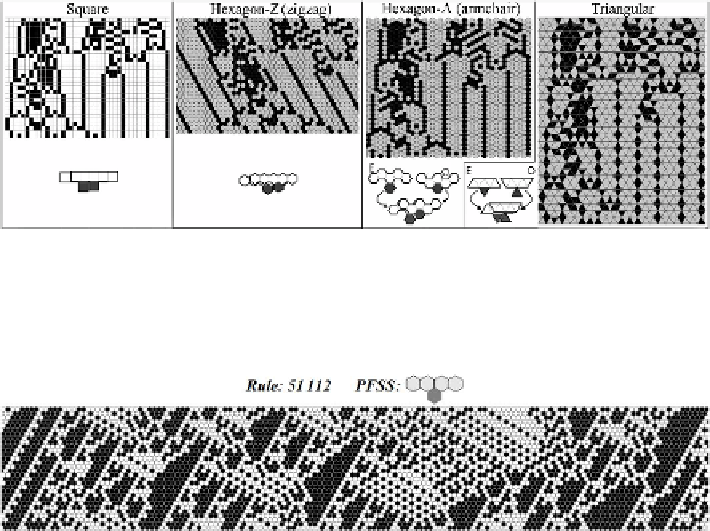Image Processing Reference
In-Depth Information
module, and the “armchair” tessellation (hexagon-A) requires two modules of dif-
ferent shapes: O and E [6]. For neighborhoods of radii of any positive integer the
triangular tessellation also requires two types of modules. Figure 11.9 illustrates the
original CASS based on CA rule {3818817080,2,2} implemented by four types of
PFSS.
11.3.5.1
PFSS on Hexagonal Grid
PFSS on hexagonal tessellation can execute 2 or 3 state CA. The following examples
are based on the former, for 3 state examples see [65]. As mentioned above, depend-
ing on orientation, there are two types of hexagonal grids: “zigzag” and “armchair”,
called hexagon-Z and hexagon-A, respectively.
Hexagon-Z: PFSS
HZ
Only one type of module is necessary to emulate 1D CA with
PF SS
HZ
.However,
as Fig. 11.9 indicates, due to the asymmetry of the module, the pattern normally
vertical, becomes skewed. It seems possible to find automata whose behavior will
compensate for this, however, implementation of half-distance automata is more
straightforward as shown in Fig. 11.10.
Fig. 11.9
CA rule {3818817080,2,2} realized by PFSS on regular tessellations. Gray lev-
els on arrays represent the opacity values achievable by particular PFSS. For each type two
modules for each tessellation are shown schematically. Coupled modules: E and O are shown
accordingly.
Fig. 11.10
The pattern produced by
PFSS
HZ
driven by 1D2C r-
2
CA rule 51112 from
Fig. 11.5.







Search WWH ::

Custom Search